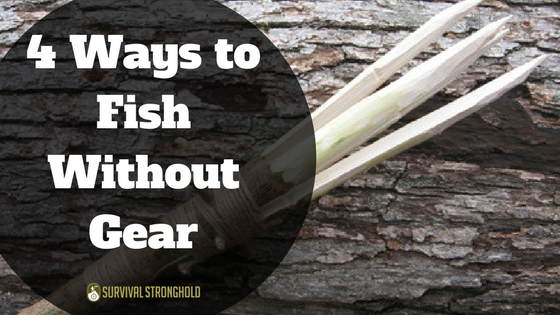Necessity is the mother of invention, right? So if you ever find yourself in a survival situation, your basic needs will force you to get creative and improvise to survive. If you haven’t built up your knowledge of which wild plants in your area are safe and edible, your safest bet for food in the wilderness is fish. Here are a few simple tips to improvise basic fishing gear so you can survive until rescue!
- Make a spear.
We’ll show you a few supplementary ways to corral your fish, but the primary way you’ll actually catch them without a pole is with a spear. Any broomstick-sized stick can be fashioned into a spear. To sharpen the point, split one end with a knife or a rock, then whittle the tip down to a nice point. Remember, water refracts light and will trick your eye into missing the fish. Take several practice strikes with other objects until you get the hang of it. When you spear a fish, don’t pull it up out of the water on the spear or the fish could slip off as it wriggles. Hold it down in the water and grab it by the gills with your hands. - Make a weir fish trap.
The weir is a time-tested rock formation which acts as a funnel. You’ll need at least a dozen cobble-sized rocks (or several dozen large sticks) to assemble in a running stream. Start by building a wall for the ‘holding’ area your fish will swim into. It should be slightly circular and large enough to hold the fish. Next, close your circle with a wide, V-shaped opening (think of a funnel) that leads the fish directly into the holding area. If the trap is large and sturdy enough, it will hold the fish and they will not swim out through the narrow opening. You can then spear them or grab them by hand. - Repurpose what you have.
If you prefer to fish with a hook and line, there are plenty of ways to get that done with common objects. Nearly any small, sharp object can be fashioned into a hook. Paperclips, soda can tabs, hair pins, twigs with sturdy thorns can all be made into hooks. To make your line, don’t be picky. Your shoelace, unraveled thread from your clothing, pieces of string, or seaweed stems make good fishing line in a pinch. Then, you can bait it with any object that will appeal to any of the fish’s senses: a tasty bit of food or a dead insect, an eye-catching bit of plastic or jewelry, get creative! Fasten your hook to your line as securely as you can, bait it, and stick with promising areas near aquatic plants. When you get a bite, don’t yank your line like you would with a regular pole, it will likely break. Instead, scoop the fish up! - Wait and scoop.
If you have ample patience and can get your hands on a plastic shopping bag, a gallon jug, a T-shirt, or a bucket to scoop up fish, this might be the easiest method for you. Stand or sit in the water with your scoop. Be as still and silent as possible as you hold your scoop in the path of passing fish. Don’t move your scoop around to catch fish, wait for them to come to you. When a fish swims into your scoop, wait until it is as far from the scoop’s opening as possible before bringing it out of the water or it could swim out!
As with recreational fishing, patience and persistence is key. Don’t wait until you’re feeling the effects of starvation to begin fishing, this is a sure-fire way to cut your patience in half. Remember, many localities strictly regulate fishing and trapping, so these methods should only be used in a dire survival situation. Be sure to cook all fish thoroughly to kill off any parasites or you’ll find yourself in more trouble than before! Good luck!
If you liked this, you might also enjoy…


